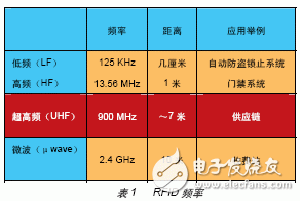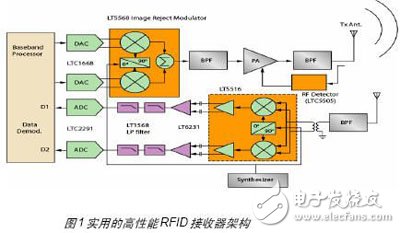Now we can know the price very quickly with a recognizer when we make a purchase in the supermarket. It is no longer a previous abacus or calculator, which speeds up the payment and is very convenient for customers. Radio Frequency Identification (RFID) technology is an automatic identification technology. Each target object corresponds to a unique electronic identification number (UID), or "electronic tag" in the RF reader. The label is attached to the object to identify the target object, such as a carton, pallet or crates. The RF card reader (transponder) reads the identification code from the electronic tag. The basic RFID system consists of three parts: an antenna or coil, a transceiver with an RFID decoder, and an RFID electronic tag (each tag has a unique electronic identification code). Table 1 shows the four commonly used RFID frequencies and their potential applications. Among them, the most widely used in commercial applications is UHF, which is likely to be widely used in supply chain management. EPC electronic label The Class-1 tag has been written at the factory, but it can also be downloaded on site. Normally, once the tag has been written, the memory is locked and the message cannot be written again. The Class-1 tag uses a conventional packet transport protocol—the reader sends a packet containing the relevant commands and data, and the tag then responds. Bad card reader application environment The reader RF radio transceiver shown in Figure 1 is a well-established design that works stably in harsh environments where there are a large number of sources of interference. Both the transmitter and receiver feature a high dynamic range direct conversion modulator and demodulator, maximizing stability and reducing cost. The core of the practical and reliable RF receiver design receiver is Linear's LT5516, a highly integrated direct conversion quadrature demodulator that provides an accurate quadrature phase shifter (0 degrees to 90 degrees). degree). The signal from the antenna is directly input to the demodulator input port through a balun after passing through the RF filter. Because of its low noise figure, the LT5516 maintains its 21.5dBm IIP3 and 9.7dB P1dB performance without the need for a low noise amplifier (LNA). When receiving data, the reader transmits a continuous carrier (unmodulated) to provide power to the tag. After receiving the request, the electronic tag responds to a code stream by amplitude-modulating the carrier. The modulation method used is amplitude shift keying (ASK) or inverse-amplitude shift keying (PR-ASK). The demodulator has two quadrature phase-shifted output ports for natural diversity reception. If a channel cannot receive a signal due to multipath or phase cancellation, the other channel (phase shifted by 90 degrees) can receive a stronger signal, and vice versa. In this way, the overall reception reliability is improved. Once demodulation is complete, the I (in-phase) and Q (quadrature phase) differential output signals can be AC ​​coupled to an operational amplifier (configured as a differential amplifier) ​​and subsequently converted to a single-ended output signal. At this time, the high-pass angle frequency should be set to 5KHz, which is lower than the minimum signal frequency of the received data stream, higher than the maximum Doppler frequency (which may be adopted by the motion label) while maintaining the frequency above the power line (60Hz). In this way, the output signal can pass through the low-pass filter smoothly using the LT1568 configured as a fourth-order low-pass. The low-pass angle frequency should be set to 5MHz so that the maximum code stream signal passes through the filter to reach the baseband. The baseband signal is then digitized by a dual low power analog-to-digital converter (LTC2291 with 12 bits resolution). Since the bandwidth of the tag stream is 5 kHz to 5 MHz, the LTC2291 is capable of adequate sampling at a rate of 25 MSps to accurately capture the demodulated signal. Additional digital filtering can also be implemented in the baseband DSP when needed. This allows the receiver to have maximum logic threshold setting flexibility that can be performed digitally by the baseband processor. Baseband tasks and digital RF channelization can increase the attractiveness and integration achieved with a full FPGA solution. The high dynamic range RF transmitter design transmitter integrates an image rejection direct conversion modulator. The LT5568's high linearity and low background noise provide excellent dynamic range performance for the transmitted signal. The modulator is capable of receiving quadrature baseband I and Q signals from a digital to analog converter (DAC) and then directly modulating to a 900 MHz transmit frequency. Curing Screen Protector,Hydrogel Phone Cutting Machine,Protective Film Cutter Machine,Screen Protcter Custting Machine Shenzhen TUOLI Electronic Technology Co., Ltd. , https://www.hydrogelprotectors.com
EPC stands for Electronic Product Code, which is the standard for RFID electronic tags, which includes the data content of electronic tags and wireless communication protocols. The EPC standard combines data information standards in bar code specifications with wireless data communication standards developed by ANSI or other standardization organizations (802.11b). The EPC standard currently applied in supply chain management belongs to the second generation EPC Class-1 standard.
The application environment of RFID may be very bad. The operating frequency of the channel is the license-free Industrial, Technology, and Medical (ISM) band. RFID readers in this band are subject to interference from cordless phones, wireless headsets, wireless data networks, and other nearby card readers. The RF receiver front end of each reader must be designed to withstand strong interfering signals and avoid distortion that can cause interrogation errors. The receiver noise must be kept low to have sufficient dynamic range to detect low-level tag response signals in a error-free manner. 